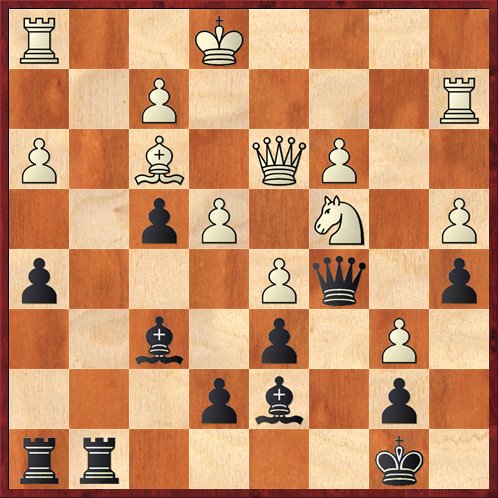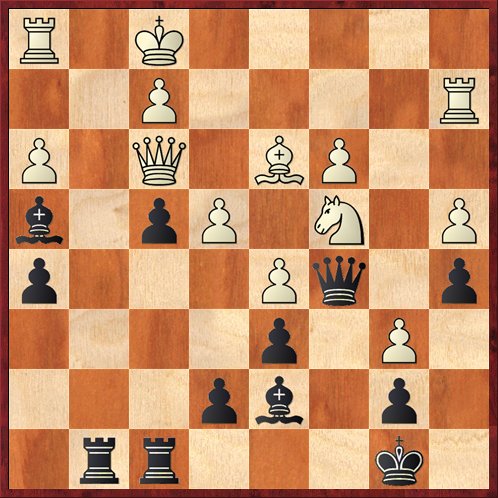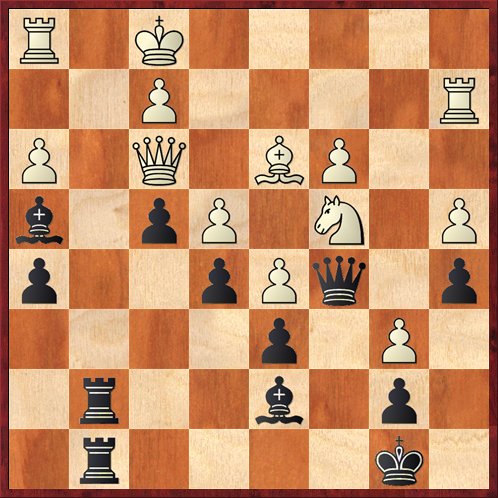I’ve just spent about five hours analyzing the finishing position of my game with Emory Tate from last weekend. Here’s the position:
Black to move.
White (IM Tate) has just played 24. Ra2 and offered a draw. What should Black do?
Let’s ask the question in multiple-choice format: Should you
(A) Accept the draw?
(B) Play the obvious 24. … Rc8?
(C) Play the more subtle 24. … Rg7?
(D) Or play the ultra-subtle 24. … Bh4?
If you want to take this quiz under tournament conditions, set your clock with about 20 minutes left to make 7 moves. If you really want to understand the position, print it out and analyze it for an hour or so (I think you’ll still be finding new ideas even after an hour!) and then come back and read my comments.
Okay, here’s my answer. In the tournament I chose (A) and I think that’s a defensible decision still. However, really the best decision, in my opinion, is (C). Here is my thinking.
(A) I took the draw for reasons that mostly did not have to do with the position. A draw would guarantee me a prize (probably a tie for third); a win would give me second place but that wasn’t enough to convince me it was worth the risk. A draw would also give my rating a nice boost, because Tate is currently rated 300 points above me.
As for the position, I certainly agree with Tate’s comment immediately after the game that he didn’t see a way for me to break through. Black is clearly better. White has multiple weaknesses: the pawns at h3, b6, c3, and a4, and his pieces are so busy protecting those weaknesses that it is very hard to come up with any sort of reasonable plan for White. Of course, White’s king is also exposed and has trouble finding a safe harbor.
Putting all these facts together, I’d say that this is a position that is risk-free for Black in the short term. I can just keep probing until the time control passes and then perhaps look for a winning plan.
However, the position is not risk-free in the long term. There are variations where Black can fall into a back-rank mate, and some rook and pawn endgames that will be lost even if the king can escape to d7. The weakness of Black’s a5 and b7 pawns can become an important factor.
In sum, the position will require delicate play to win, and there is a possibility of screwing up. So with a prize in the balance and a very strong opponent, I think that accepting the draw offer was reasonable. But of course disappointing for the spectators!
(B) Tate’s draw offer was mainly based on variations like 24. … Rc8 25. Be2 Rhg8 26. Qf3 Rcf8 27. Kf1 Bh4 27. Bd3 where Black’s position obviously looks good but it’s not really clear what to do next.
Still searching for a breakthrough.
(C) The move I was planning to play (if Tate had not offered the draw) was 24. … Rg7, and in fact this seems to be best! Black wants to keep a rook on the g-file and move the other rook to c8 (in some lines) or simply to double rooks on the g-file in other lines.
The line that bests illustrates Black’s ideas (found with some help from Rybka) is this one:
25. Kf1 (There are lots of other possibilities for White, but he generally has to play this move eventually to keep Black’s rooks out of the back rank or g2) 25. … Rc8 26. Be2 Bh4 27. Qf3 (In general, White would like to play 27. Qd4 and trade queens, but in this position it doesn’t work out too well because after 27. … Qxd4 28. cd f3! 29. Bd3 R8g8 and White’s kingside collapses because of the threat of 30. … Bxh3+) 27. … R8g8 (Notice the way Black’s rook shuttles back and forth between c8 and g8, depending on where White’s pieces are) 28. Bd3 (White has to create luft; if 28. Qxf4? Bxh3+!! forces mate or wins the queen) 28. … e5!!
ZUGZWANG!
Well, I realize it’s a stretch to say that I “missed” a zugzwang when it was five moves deep and involves a lot of unforced moves. But still, what a sensational position! All possible moves weaken White’s position fatally.
(a) 29. de? Bxe6 and the knight dies.
(b) On any queen move, 29. … Bxh3+!! wins, mostly because the queen has moved away from the defense of the f2 pawn. After the king is forced to e2, … Qxf2 will be mate.
(c) 29. Be2 likewise allows 29. … Bxh3+! and any other bishop move drops the knight.
(d) Any knight move drops the c3 pawn or worse.
(e) 29. Rh2 allows 29. … Rg1+ 30. Ke2 Bg4! 31. hg hg trapping White’s queen.
(f) 29. Ra1 unprotects the f-pawn and again allow the familiar stuff with 29. … Bxh3+! 30. Rxh3 Bxf2! Also, Rybka points out that 29. … Rg2 is very good.
(g) 29. Ra3 allows 29. … Rg1+! (another repeated theme in the position) 30. Rxg1 Bxh3+ 31. Ke2 Rxg1 followed by 31. … Bg4 trapping White’s queen.
(h) 29. Rc2 (or anywhere on the second rank) drops the a-pawn. It looks as if 29. … Bxa4 30. Ra2 might still work for White, but after 30. … Rg2 it turns out that White can’t actually take the bishop.
I think that in some ways this position is better than the famous “Immortal Zugzwang Game” between Saemisch and Nimzovich because the refutations to White’s tries are less obvious.
As I said, there are lots of other things White can do after 24. … Rg7 but the lines above show the wealth of ideas Black can work with: doubling on the g-file, penetrating to g2, penetrating to g1 and taking over the back rank, sacrifices on h3 or g4, checkmates on f2. As a practical matter it’s very hard for White to keep track of all these possibilities. He’s like the proverbial boy with his finger in the dike.
(D) I didn’t even consider 24. … Bh4 during the game, but when I was analyzing at home I initially thought that this was the winning move. Again, the idea is to say to White, “Play a move! Any move!” Unfortunately, when I put it on Rybka, it found the simple reply 25. Qd4. White isn’t out of the woods, but obviously a queen trade helps him defend. And even if the queen trade doesn’t happen, the queen on d4 solidifies his control over the vulnerable f2 square.
Hope you found this position as interesting as I did!
P.S. By the way, I checked the results of the tournament online. George Mandrusov won his last-round game against Nick Karas and tied with me for third place. As reported earlier, Tate was second and Milos Pavlovic was first.





